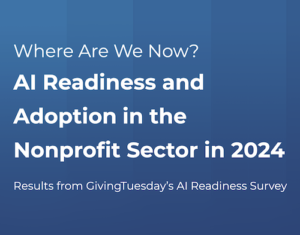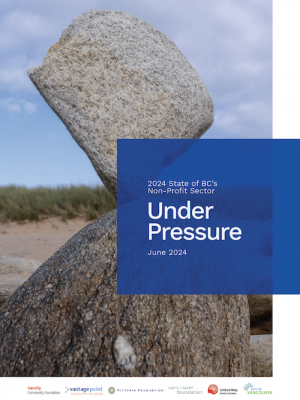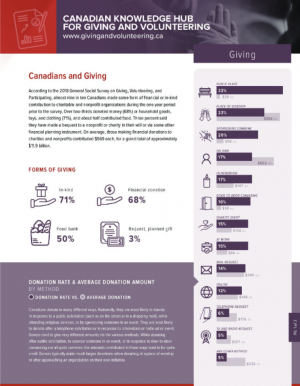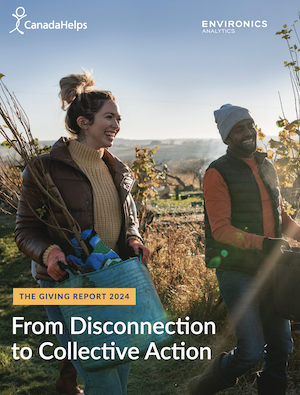 The Indiana University Lilly Family School of Philanthropy issued The 2025 Global Philanthropy Environment Index Canada and The 2025 Global Philanthropy Environment Index: Canada & United States Regional Report, part of its The Global Philanthropy Environment Index 2025. The seven-page report about Canada is by Adam Aptowitzer, of KPMG Law LLP, and grades Canada based on questions like “To what extent is there government discretion in shutting down philanthropic organizations?” and “To what extent are public policies and practices favorable for philanthropy?” He provides key recommendations for improving the environment for philanthropy, including a suggestion that federal and provincial governments cooperate to address tax regulations and incentives. The Global Philanthropy Environment Index 2025 Executive Summary is also available.
The Indiana University Lilly Family School of Philanthropy issued The 2025 Global Philanthropy Environment Index Canada and The 2025 Global Philanthropy Environment Index: Canada & United States Regional Report, part of its The Global Philanthropy Environment Index 2025. The seven-page report about Canada is by Adam Aptowitzer, of KPMG Law LLP, and grades Canada based on questions like “To what extent is there government discretion in shutting down philanthropic organizations?” and “To what extent are public policies and practices favorable for philanthropy?” He provides key recommendations for improving the environment for philanthropy, including a suggestion that federal and provincial governments cooperate to address tax regulations and incentives. The Global Philanthropy Environment Index 2025 Executive Summary is also available.
 Through interviews, workshops and an online survey of 50 foundations, Building Foundations for Collaborative Transformation: A Philanthropy Sector Needs Analysis, from The Partnering Initiative, Wings and Philea, presents challenges in the sector and key findings for collaboration, including:
Through interviews, workshops and an online survey of 50 foundations, Building Foundations for Collaborative Transformation: A Philanthropy Sector Needs Analysis, from The Partnering Initiative, Wings and Philea, presents challenges in the sector and key findings for collaboration, including:
– There is a clear trajectory within foundations toward more transformational multi-sector collaboration.
– Community-led or -based organizations have the highest engagement and confidence among foundations.
The 43-page report also lists some of the systemic barriers to collaboration.
 Impact Investing and Donor-Advised Funds in Canada (2025): This year, assets held in DAFs in Canada are estimated to hit $12.4 billion, with more than $1 billion being granted to charities each year. Will this grow? At a time when many philanthropists want to align their investing with their values, Dr. Sharilyn Hale, in collaboration with research partner Keith Sjogren, spoke with donors, DAF foundations and wealth advisors to identify the potential for wider adoption of impact investing with capital held in DAFs. Reports, from TwinRiver Capital, are available in summary and full formats.
Impact Investing and Donor-Advised Funds in Canada (2025): This year, assets held in DAFs in Canada are estimated to hit $12.4 billion, with more than $1 billion being granted to charities each year. Will this grow? At a time when many philanthropists want to align their investing with their values, Dr. Sharilyn Hale, in collaboration with research partner Keith Sjogren, spoke with donors, DAF foundations and wealth advisors to identify the potential for wider adoption of impact investing with capital held in DAFs. Reports, from TwinRiver Capital, are available in summary and full formats.
 Unlocking Generosity: Understanding and Engaging Multicultural Canadians in Charitable Giving (2025), from Imagine Canada, is the second report to present findings from the Multicultural Charitable Giving Study. The first report, Navigating New Horizons, focused on demographic trends and multicultural experiences in giving. The current report, which surveyed 3,074 South Asian, Chinese, Afro-Caribbean, Filipino, Arab and West Asian individuals in March-May 2024, examines donation methods, the role of multicultural media, intentionality in giving, and the potential for greater support.
Unlocking Generosity: Understanding and Engaging Multicultural Canadians in Charitable Giving (2025), from Imagine Canada, is the second report to present findings from the Multicultural Charitable Giving Study. The first report, Navigating New Horizons, focused on demographic trends and multicultural experiences in giving. The current report, which surveyed 3,074 South Asian, Chinese, Afro-Caribbean, Filipino, Arab and West Asian individuals in March-May 2024, examines donation methods, the role of multicultural media, intentionality in giving, and the potential for greater support.
 Philanthropic Foundations Canada released a 25-page brief, Trump 2.0 and US Philanthropy: Reflections and Actions for Canadian Philanthropic Foundations (March 2025), explaining the effects of recent US policies on the US philanthropic sector, and suggesting actions for Canadian foundations, including: develop a continuum of support, and consider transferring capital to under-served communities, as demonstrated by Laidlaw Foundation, Inspirit Foundation, and McConnell Foundation in the Indigenous Peoples Resilience Fund. The final section of the brief outlines clear steps for leaders to define their role in civil society, use data to guide decisions, and openly share the impact of philanthropy. At its core, the brief calls for moral citizenship of care – a reminder that in moments like these, philanthropy must decide whether to retreat, adapt or rise to meet the moment.
Philanthropic Foundations Canada released a 25-page brief, Trump 2.0 and US Philanthropy: Reflections and Actions for Canadian Philanthropic Foundations (March 2025), explaining the effects of recent US policies on the US philanthropic sector, and suggesting actions for Canadian foundations, including: develop a continuum of support, and consider transferring capital to under-served communities, as demonstrated by Laidlaw Foundation, Inspirit Foundation, and McConnell Foundation in the Indigenous Peoples Resilience Fund. The final section of the brief outlines clear steps for leaders to define their role in civil society, use data to guide decisions, and openly share the impact of philanthropy. At its core, the brief calls for moral citizenship of care – a reminder that in moments like these, philanthropy must decide whether to retreat, adapt or rise to meet the moment.
 The Canadian Centre for Nonprofit Digital Resilience recently released Bridging the digital divide: A strategic vision for Canada’s nonprofit sector (2025) to inform nonprofit leaders about their roles in digital equity and digital inclusivity. Also, at the end of 2024, they made available an easy-to-read, five-step guideline for nonprofits to develop a cybersecurity plan and to manage cyber risks: A Cybersecurity On-Ramp for the Settlement Sector. It’s for the settlement sector (organizations that provide services and support to immigrants and refugees), but any organization can use this well written guideline.
The Canadian Centre for Nonprofit Digital Resilience recently released Bridging the digital divide: A strategic vision for Canada’s nonprofit sector (2025) to inform nonprofit leaders about their roles in digital equity and digital inclusivity. Also, at the end of 2024, they made available an easy-to-read, five-step guideline for nonprofits to develop a cybersecurity plan and to manage cyber risks: A Cybersecurity On-Ramp for the Settlement Sector. It’s for the settlement sector (organizations that provide services and support to immigrants and refugees), but any organization can use this well written guideline.
 “Report #4 of the Advisory Committee on the Charitable Sector – October 2024” is titled Towards a federal regulatory environment that enables and strengthens the charitable and nonprofit sector. The recommendations are grouped by four working groups:
“Report #4 of the Advisory Committee on the Charitable Sector – October 2024” is titled Towards a federal regulatory environment that enables and strengthens the charitable and nonprofit sector. The recommendations are grouped by four working groups:
1) Definition of charity and charitable purpose working group;
2) National Inherent Risk Assessment working group;
3) Transparency and data related to other qualified donees and non-profit organizations working group; and
4) Relationship between the CRA and the charitable sector working group.
 GivingTuesday issued a few reports in 2024 that are relevant to Canadians, including:
GivingTuesday issued a few reports in 2024 that are relevant to Canadians, including:
1) The Giving Bridge: A Lookback at 2023 Trends in Global Generosity. It’s from GivingTuesday Data Commons and investigates the nature of generosity globally using quantitative and qualitative methods. Among key findings: “Despite philanthropic pessimism resulting from downward donor trends in money raised and participation rates, most people remain open and ready to help those most in need. In other words, the giving ecosystem is as robust as ever, and it appears increasingly clear that it is nonprofits who must adapt and redesign their relationship with givers to overcome the steady declines in donors and dollars.”
2) Civic Intent: A Deeper Dive on Civic Engagement Using the U.S. GivingPulse Survey. This special report looks at trends in giving behaviour and perspectives in the US, including the finding that “people in the US who are surrounded by prompts and reminders to participate in generosity-related activities are more likely to participate in them.”
 The Ontario Nonprofit Network released its 2024 State of the Sector – Policy Report, called Built on Hope: Nonprofit Sector Seeking Stability. The 23-page report focuses on the fact that the nonprofit sector in the province is still experiencing financial struggles, even as demand for services increase. The report lists policy recommendations for government and calls to action for the public and the sector, including: build diverse networks; engage in collective advocacy; socialize the Nonprofit Business Model; and encourage local community engagement and support.
The Ontario Nonprofit Network released its 2024 State of the Sector – Policy Report, called Built on Hope: Nonprofit Sector Seeking Stability. The 23-page report focuses on the fact that the nonprofit sector in the province is still experiencing financial struggles, even as demand for services increase. The report lists policy recommendations for government and calls to action for the public and the sector, including: build diverse networks; engage in collective advocacy; socialize the Nonprofit Business Model; and encourage local community engagement and support.
 A new report from US-based GivingTuesday, AI Readiness and Adoption in the Nonprofit Sector in 2024: Results from GivingTuesday’s AI Readiness Survey, contains a few, great insights. As with many other reports about artificial intelligence (AI), this one focuses mainly on people who use ChatGPT, DALL-E 3 and other generative AI services that create text or images — services that have already saturated the market and have minimal relevance to nonprofit work. Interestingly, the report contains a few mentions about newer AI tools that might be useful to the sector, such as tools related to data interpretation and task management. An example: “Our comparison of current and future use of AI suggests that the greatest unmet needs are apps that help in organizing and restructuring data, followed by virtual AI assistants, data interpretation/analysis, and predictive models (which require large amounts of this structured data as a key input). Generative AI and chatbot-use have already saturated the market; anyone who wants this has tried it.”
A new report from US-based GivingTuesday, AI Readiness and Adoption in the Nonprofit Sector in 2024: Results from GivingTuesday’s AI Readiness Survey, contains a few, great insights. As with many other reports about artificial intelligence (AI), this one focuses mainly on people who use ChatGPT, DALL-E 3 and other generative AI services that create text or images — services that have already saturated the market and have minimal relevance to nonprofit work. Interestingly, the report contains a few mentions about newer AI tools that might be useful to the sector, such as tools related to data interpretation and task management. An example: “Our comparison of current and future use of AI suggests that the greatest unmet needs are apps that help in organizing and restructuring data, followed by virtual AI assistants, data interpretation/analysis, and predictive models (which require large amounts of this structured data as a key input). Generative AI and chatbot-use have already saturated the market; anyone who wants this has tried it.”
 Under Pressure: 2024 State of BC’s Non-Profit Sector Report (from Vantage Point, Vancouver Foundation, Victoria Foundation, City of Vancouver, United Way British Columbia and Vancity Community Foundation) surveyed 558 nonprofit organizations and found: (1) expenses soared and all revenue sources decreased, except for government revenue; and (2) demand for services for clients and communities skyrocketed, while capacity to deliver those services remained the same. Read the full report, which includes recommendations to government, funders, sector stakeholders and partners.
Under Pressure: 2024 State of BC’s Non-Profit Sector Report (from Vantage Point, Vancouver Foundation, Victoria Foundation, City of Vancouver, United Way British Columbia and Vancity Community Foundation) surveyed 558 nonprofit organizations and found: (1) expenses soared and all revenue sources decreased, except for government revenue; and (2) demand for services for clients and communities skyrocketed, while capacity to deliver those services remained the same. Read the full report, which includes recommendations to government, funders, sector stakeholders and partners.
 The Canadian Knowledge Hub for Giving and Volunteering is an online centre for data about giving and volunteering. It accesses a lot of data from a variety of sources, including a huge amount of data from Statistics Canada, such as data in the General Social Survey on Giving, Volunteering and Participating (GSS-GVP). The hub contains reports, resources, infographics and links to StatCan data about our sector. It was launched by Volunteer Canada in partnership with Imagine Canada, Ajah, Association of Fundraising Professionals of Canada, and Volunteer Management Professionals of Canada.
The Canadian Knowledge Hub for Giving and Volunteering is an online centre for data about giving and volunteering. It accesses a lot of data from a variety of sources, including a huge amount of data from Statistics Canada, such as data in the General Social Survey on Giving, Volunteering and Participating (GSS-GVP). The hub contains reports, resources, infographics and links to StatCan data about our sector. It was launched by Volunteer Canada in partnership with Imagine Canada, Ajah, Association of Fundraising Professionals of Canada, and Volunteer Management Professionals of Canada.
 CanadaHelps collaborated with Environics Analytics and Imagine Canada to release The Giving Report 2024: From Disconnection to Collective Action. Aside from the usual data (the number of Canadians making donations has fallen again and more than half of charities can’t meet demands for their services), this Giving Report contains new information. For example, 32% of Canadians say climate change or protecting our environment is a top cause, but only 3.9% of donations are made to environmental charities or climate-driven crises, such as wildfires (see pages 26-31 of the 51-page pdf). Also, online giving is now stagnating (which, for years, has grown even as overall donations have fallen), but there are still bright spots in online activity (see pages 11-14). And, of course, the Supplemental Data Tables are full of thousands of searchable insights (pages 41-50).
CanadaHelps collaborated with Environics Analytics and Imagine Canada to release The Giving Report 2024: From Disconnection to Collective Action. Aside from the usual data (the number of Canadians making donations has fallen again and more than half of charities can’t meet demands for their services), this Giving Report contains new information. For example, 32% of Canadians say climate change or protecting our environment is a top cause, but only 3.9% of donations are made to environmental charities or climate-driven crises, such as wildfires (see pages 26-31 of the 51-page pdf). Also, online giving is now stagnating (which, for years, has grown even as overall donations have fallen), but there are still bright spots in online activity (see pages 11-14). And, of course, the Supplemental Data Tables are full of thousands of searchable insights (pages 41-50).
Archive of Top Reports
Banner photo is courtesy of Jeremy Bishop.
